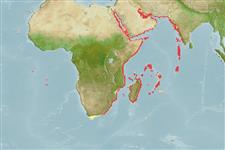>
Anguilliformes (Eels and morays) >
Muraenidae (Moray eels) > Muraeninae
Etymology: Gymnothorax: Greek, gymnos = naked + Greek, thorax, -akos = breast (Ref. 45335).
More on author: Lacepède.
Environment: milieu / climate zone / depth range / distribution range
Ecología
marino asociado a arrecife; rango de profundidad 1 - 40 m (Ref. 30573). Tropical
Western Indian Ocean: throughout the area, including the Red Sea.
Tamaño / Peso / Age
Maturity: Lm ? range ? - ? cm
Max length : 65.0 cm TL macho / no sexado; (Ref. 9710)
Short description
Morfología | Morfometría
Head brownish with conspicuous lines of black dots (Ref. 3257). Body lilac with brown marbling (Ref. 3257).
Found in shallow coastal waters, on coral and rocky reefs (Ref. 30573). Simultaneous hermaphroditism is confirmed for this species (Ref. 103751).
Simultaneous hermaphroditism is confirmed using good diagnostic criteria (Ref. 103751).
Böhlke, E.B. and J.E. Randall, 1999. Gymnothorax castlei, a new species of Indo-Pacific moray eel (Anguilliformes: Muraenidae). Raffles Bull. Zool. 47(2):549-554. (Ref. 35991)
IUCN Red List Status (Ref. 130435)
Threat to humans
Harmless
Human uses
Más información
Age/SizeCrecimientoLength-weightLength-lengthLength-frequenciesMorfometríaMorfologíaLarvaDinámica larvariaReclutamientoAbundanciaBRUVS
ReferenciasAcuiculturaPerfil de acuiculturaRazasGenéticaElectrophoresesheritabilidadEnfermedadesProcesamientoNutrientsMass conversion
Herramientas
Special reports
Download XML
Fuentes de Internet
Estimates based on models
Preferred temperature (Ref.
123201): 24.6 - 29.3, mean 27.3 °C (based on 182 cells).
Phylogenetic diversity index (Ref.
82804): PD
50 = 0.5000 [Uniqueness, from 0.5 = low to 2.0 = high].
Bayesian length-weight: a=0.00047 (0.00025 - 0.00089), b=3.28 (3.13 - 3.43), in cm total length, based on LWR estimates for this Genus-body shape (Ref.
93245).
Nivel trófico (Ref.
69278): 4.0 ±0.6 se; based on size and trophs of closest relatives
Resiliencia (Ref.
120179): Medio, población duplicada en un tiempo mínimo de 1.4-4.4 años (Fec = 8,000-12,000).
Fishing Vulnerability (Ref.
59153): Moderate to high vulnerability (46 of 100).
Nutrients (Ref.
124155): Calcium = 36 [20, 67] mg/100g; Iron = 0.462 [0.279, 0.977] mg/100g; Protein = 18.8 [16.5, 21.3] %; Omega3 = 0.11 [0.05, 0.31] g/100g; Selenium = 38.1 [21.2, 75.7] μg/100g; VitaminA = 73.4 [22.6, 225.2] μg/100g; Zinc = 0.972 [0.691, 1.341] mg/100g (wet weight);
